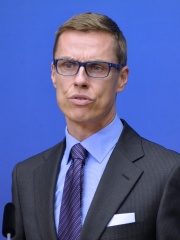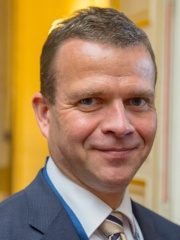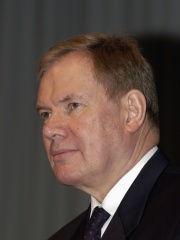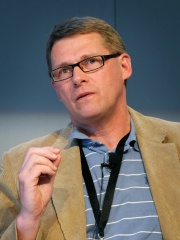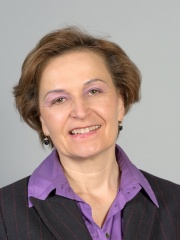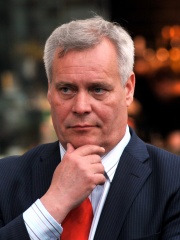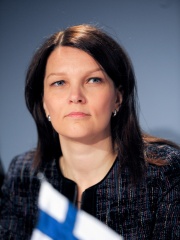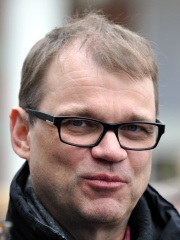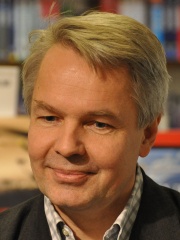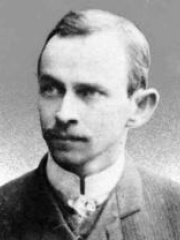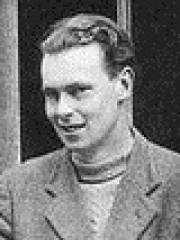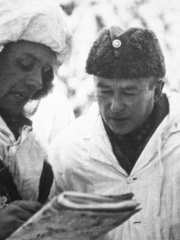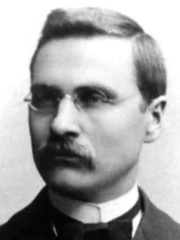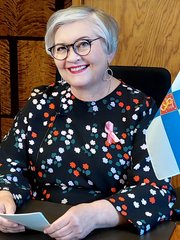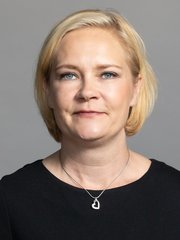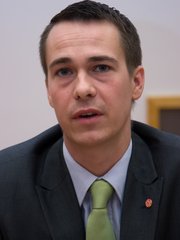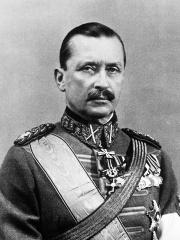
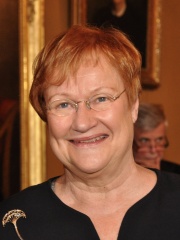
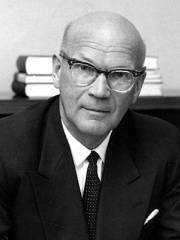
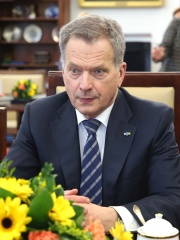
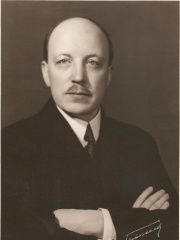
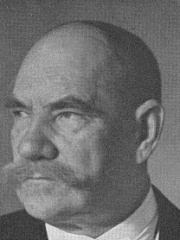
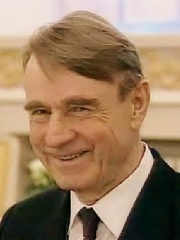
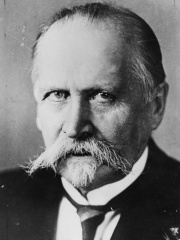
The Most Famous
POLITICIANS from Finland
This page contains a list of the greatest Finnish Politicians. The pantheon dataset contains 19,576 Politicians, 120 of which were born in Finland. This makes Finland the birth place of the 32nd most number of Politicians behind South Korea, and Bulgaria.
Top 10
The following people are considered by Pantheon to be the top 10 most legendary Finnish Politicians of all time. This list of famous Finnish Politicians is sorted by HPI (Historical Popularity Index), a metric that aggregates information on a biography's online popularity. Visit the rankings page to view the entire list of Finnish Politicians.

1. Carl Gustaf Emil Mannerheim (1867 - 1951)
With an HPI of 81.28, Carl Gustaf Emil Mannerheim is the most famous Finnish Politician. His biography has been translated into 78 different languages on wikipedia.
Baron Carl Gustaf Emil Mannerheim (Finland Swedish: [kɑːrl ˈɡʉstɑv ˈeːmil ˈmɑnːærhejm] , 4 June 1867 – 27 January 1951) was a Finnish military commander and statesman. He served as the military leader of the Whites in the Finnish Civil War (1918), as regent of Finland (1918–1919), as commander-in-chief of the Finnish Defence Forces during World War II (1939–1945), and as the president of Finland (1944–1946). He became Finland's only field marshal in 1933 and was appointed honorary Marshal of Finland in 1942. Born into a Swedish-speaking aristocratic family in the Grand Duchy of Finland, Mannerheim made a career in the Imperial Russian Army, serving in the Russo-Japanese War and the Eastern Front of World War I and rising by 1917 to the rank of lieutenant general. He had a prominent place in the 1896 coronation ceremonies for Emperor Nicholas II and later had several private meetings with him. After the Bolshevik coup of November 1917 in Russia, Finland declared its independence on 6 December, but soon became embroiled in the 1918 Finnish Civil War between the Whites, who were the troops of the Senate of Finland, supported by troops of the German Empire, and the pro-Bolshevik Reds. A Finnish delegation appointed Mannerheim as the military chief of the Whites in January 1918; and he led them to victory, holding a triumphal victory parade in Helsinki in May. After spending some time abroad, he was invited back to Finland to serve as the country's second regent, or head of state, from December 1918 to July 1919. He secured the recognition of Finnish independence by multiple Entente powers and, despite being a monarchist, formally ratified the republican Constitution of Finland. He then ran against K. J. Ståhlberg in the first Finnish presidential elections in 1919 but lost and quit politics. Mannerheim helped found the Mannerheim League for Child Welfare in 1920 and headed the Finnish Red Cross from 1922 to his death. He was restored to a central role in national defence policy when President Svinhufvud appointed him as the Chairman of the Finnish Defence Council in 1931, tasked with making preparations for a potential war with the Soviet Union. It was also agreed that he would temporarily take over as commander-in-chief of the country's armed forces should there be a war. Accordingly, after the Soviet Union invaded Finland in November 1939 in what became the Winter War, Mannerheim replaced President Kyösti Kallio as commander-in-chief, and occupied the post for the next five years. He became a unifying symbol of the war effort and part of the core leadership of the country. He personally participated in the planning of Operation Barbarossa and led the Finnish Defence Forces in an invasion of the Soviet Union alongside Nazi Germany known as the Continuation War (1941–1944). In 1944, when the prospect of Nazi Germany's defeat in World War II became clear, the Parliament of Finland unanimously appointed Mannerheim as the President, and he oversaw peace negotiations with the Soviet Union and the United Kingdom, leading to the Lapland War. Already in declining health, he resigned the presidency in 1946 and spent much of his remaining life in a sanatorium in Switzerland, where he wrote his memoirs, and where he died in 1951. Participants in a Finnish survey taken 53 years after his death voted Mannerheim the greatest Finn of all time. During his own lifetime he became, alongside Jean Sibelius, the best-known Finnish personage at home and abroad. According to historian Tuomas Tepora[fi], a cult of personality began to be built around Mannerheim after the civil war. Given the broad recognition in Finland and elsewhere of his unparalleled role in establishing and later preserving Finland's independence from the Soviet Union, Mannerheim has long been referred to as the father of modern Finland, and the New York Times called the Finnish capital Helsinki's Mannerheim Museum, memorializing the leader's life and times, "the closest thing there is to a [Finnish] national shrine".

2. Tarja Halonen (b. 1943)
With an HPI of 75.27, Tarja Halonen is the 2nd most famous Finnish Politician. Her biography has been translated into 82 different languages.
Tarja Kaarina Halonen (pronounced [ˈtɑrjɑ (ˈkɑːrinɑ) ˈhɑlonen] , born 24 December 1943) is a Finnish politician who served as the president of Finland, and the first and to date only woman to hold the position, from 2000 to 2012. She first rose to prominence as a lawyer with the Central Organisation of Finnish Trade Unions (SAK), and as the prime minister's parliamentary secretary (1974–1975) and a member of the City Council of Helsinki (1977–1996). Halonen was a Social Democratic Party member of parliament from 1979 until her election to the presidency in 2000. She also served as a minister at the Ministry of Social Affairs and Health from 1987 to 1990, as Minister of Justice from 1990 to 1991, and as Minister for Foreign Affairs from 1995 to 2000. Halonen was an extremely popular president, with her approval ratings reaching a peak of 88 percent in December 2003. She was re-elected in 2006, defeating National Coalition Party candidate Sauli Niinistö in the second round by 51% to 48%. Ineligible to run in the 2012 presidential elections because of term limits, Halonen left office on 1 March 2012 and was succeeded by Niinistö. Widely known for her interest in human rights issues, Halonen served as the chairperson of the Finnish LGBT rights organization Seta in the 1980s, and she actively participated in the discussion of issues such as women's rights and the problems of globalization during her presidency. In 2006, she was mentioned by various commentators as a potential candidate for the United Nations Secretary-General selection, but she denied an interest at that time, stating that she wanted to finish her term as president before thinking about other career options. In 2009, Forbes named her among the 100 most powerful women in the world. Halonen is a member of the Council of Women World Leaders, an international network of current and former women presidents and prime ministers whose mission is to mobilize the highest-level women leaders globally for collective action on issues of critical importance to women and equitable development. Since the death of Martti Ahtisaari in 2023, Halonen is currently the oldest living former president of Finland.

3. Urho Kekkonen (1900 - 1986)
With an HPI of 74.02, Urho Kekkonen is the 3rd most famous Finnish Politician. His biography has been translated into 67 different languages.
Urho Kaleva Kekkonen (Finnish pronunciation: [ˈurho ˈkɑleʋɑ ˈkekːonen] ; 3 September 1900 – 31 August 1986), often referred to by his initials UKK, was a Finnish politician who served as the eighth and longest-serving president of Finland from 1956 to 1982. He also served as prime minister (1950–1953, 1954–1956), and held various other cabinet positions. He was the third and most recent president from the Agrarian League/Centre Party. Head of state for nearly 26 years, he dominated Finnish politics for 31 years overall. Holding a large amount of power, he won his later elections with little opposition and has often been classified as an autocrat. As president, Kekkonen continued the "active neutrality" policy of his predecessor President Juho Kusti Paasikivi that came to be known as the Paasikivi–Kekkonen doctrine, under which Finland was to retain its independence while maintaining good relations and extensive trade with members of both NATO and the Warsaw Pact. Critical commentators referred to this policy of appeasement pejoratively as Finlandization. He is credited by Finnish historians for his foreign and trade policies, which allowed Finland's market economy to keep pace with Western Europe even with the Soviet Union as a neighbor, and for Finland to gradually take part in the European integration process. On the other hand, his perceived hunger for power, his divide-and-rule attitude in domestic politics and the lack of genuine political opposition, especially during the latter part of his presidency, significantly weakened Finnish democracy during his presidency. Kekkonen was nominated for the Nobel Peace Prize in 1962 for his "tireless efforts and success at keeping peace and security in the Nordic countries, and therefore contributing to civic peace and reconciliation in the World". He was also considered a potential candidate for the prize on later occasions. Narrowly elected in the 1956 presidential election, Kekkonen consolidated power by successfully presenting himself as an indispensable "guarantor" of Soviet relations in a tense and politically unstable period. He was reelected in 1962 in the aftermath of the Note Crisis and the withdrawal of the main opposition candidate. Kekkonen typically favoured appointing "popular front" cabinets composed of centrist and left-wing parties trusted by the Soviet Union while leaving out the major right-wing National Coalition Party. He was elected to a third six-year term in 1968 and achieved the height of his power in the 1970s; in 1973, an emergency law extending his term by four years passed the Parliament with 170 votes for and only 28 against. In 1975, considered the peak year of his career, Kekkonen hosted the Conference on Security and Co-operation in Europe in Helsinki and resolved a domestic political crisis by pressuring party leaders into joining a new "popular front" cabinet in front of television cameras. He was elected to his fourth and final term by an overwhelming margin in 1978, but his health and mental faculties visibly deteriorated, forcing him to submit his resignation in late 1981 and retire. After Kekkonen's presidency, the reform of the Constitution of Finland was initiated by his successors to increase the power of the Parliament and the prime minister at the expense of the president and to introduce a term limit. Kekkonen was a member of the Parliament of Finland from 1936 until his rise to the presidency. Either prior, during or between his premierships, he served as minister of justice (1936–37, 1944–46, 1951), minister of the interior (1937–39, 1950–51), speaker of the Finnish Parliament (1948–50) and minister of foreign affairs (1952–53, 1954). In addition to his extensive political career, he was a lawyer by education, a policeman and athlete in his youth, a veteran of the Finnish Civil War, and an enthusiastic writer. During World War II, his anonymous reports on the war and foreign politics received a large audience in the Suomen Kuvalehti magazine. Even during his presidency, he wrote humorous, informal columns (causerie) for the same magazine, edited by his long-time friend Ilmari Turja, under several pseudonyms.

4. Sauli Niinistö (b. 1948)
With an HPI of 73.22, Sauli Niinistö is the 4th most famous Finnish Politician. His biography has been translated into 87 different languages.
Sauli Väinämö Niinistö (Finnish pronunciation: [ˈsɑu̯li ˈʋæinæmø ˈniːnistø], born 24 August 1948) is a Finnish politician who served as the president of Finland from 2012 to 2024. A lawyer by education, Niinistö was Chairman of the National Coalition Party (NCP) from 1994 to 2001, Minister of Justice from 1995 to 1996, Minister of Finance from 1996 to 2003, Deputy Prime Minister from 1995 to 2001 and the NCP candidate in the 2006 presidential election. He served as the Speaker of the Parliament of Finland from 2007 to 2011 and has been the honorary president of the European People's Party (EPP) since 2002. Niinistö was the NCP candidate in the 2012 presidential election, defeating Pekka Haavisto of the Green League (VIHR) with 62.6% of the vote in the decisive second round. Niinistö assumed office on 1 March 2012; he is the first NCP president since Juho Kusti Paasikivi, who left office in 1956. In May 2017, Niinistö announced that he would seek reelection in the 2018 presidential election, running as an Independent candidate. The NCP and Christian Democrats (KD) supported his candidacy. He won reelection in the first round on 28 January 2018 with 62.7% of the vote and his second term began on 1 February 2018. In a 2023 poll conducted by MTV Uutiset, Niinistö was ranked as Finland's greatest president of all time.
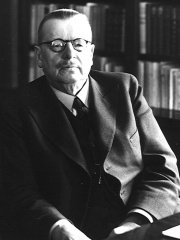
5. Juho Kusti Paasikivi (1870 - 1956)
With an HPI of 73.17, Juho Kusti Paasikivi is the 5th most famous Finnish Politician. His biography has been translated into 59 different languages.
Juho Kusti Paasikivi (Finnish pronunciation: [ˈjuho ˈkusti ˈpɑːsiˌkiʋi], 27 November 1870 – 14 December 1956) was a Finnish politician who served as the president of Finland from 1946 to 1956. Representing the Finnish Party until its dissolution in 1918 and then the National Coalition Party, he previously served as senator, member of parliament (1907–1909, 1910–1914), envoy to Stockholm (1936–1939) and Moscow (1940–1941), and Prime Minister of Finland (1918 and 1944–1946). He also held several other positions of trust, and was an influential figure in Finnish economics and politics for over fifty years. Paasikivi has been remembered as a tenacious and temperamental character, but also as a realistic peace negotiator and a main architect of Finland's foreign policy after the Second World War; for example, the Paasikivi Society (Paasikivi-seura), founded in 1958 under the leadership of Jan-Magnus Jansson, sought to nurture Paasikivi's political legacy, especially during the Cold War, by promoting 'fact-based foreign policy thinking' in Finland and making Finland's policy of neutrality internationally known. Paasikivi was also the last Finnish president born in the 19th century and the "lowest" in terms of social origin.

6. Risto Ryti (1889 - 1956)
With an HPI of 71.68, Risto Ryti is the 6th most famous Finnish Politician. His biography has been translated into 51 different languages.
Risto Heikki Ryti (Finnish pronunciation: [ˈristo ˈhei̯kːi ˈryti]; 3 February 1889 – 25 October 1956) was a Finnish politician who served as the president of Finland from 1940 to 1944. Ryti started his career as a politician in the field of economics and as a political background figure during the interwar period. He made a wide range of international contacts in the world of banking and within the framework of the League of Nations. Ryti served as prime minister during the Winter War and the Interim Peace, and as president during the Continuation War. Ryti penned the 1944 Ryti–Ribbentrop Agreement – named after himself and Joachim von Ribbentrop – a personal letter to Nazi German Führer Adolf Hitler whereby Ryti agreed not to reach a separate peace in the Continuation War against the Soviet Union without approval from Nazi Germany, in order to secure German military aid for Finland to stop the Soviet Vyborg–Petrozavodsk Offensive against Finland. His resignation soon afterwards allowed his successor, Carl Gustaf Emil Mannerheim, to bypass the agreement and make peace with the Soviet Union once the offensive had been stopped. After the war, Ryti was the main defendant in the Finnish war-responsibility trials (1945–1946), which resulted in his conviction for crimes against peace. He was sentenced to ten years' imprisonment but was pardoned by decision of President Juho Kusti Paasikivi in 1949. His reputation was largely unscathed, but his health had suffered and he never returned to public life.

7. Pehr Evind Svinhufvud (1861 - 1944)
With an HPI of 71.36, Pehr Evind Svinhufvud is the 7th most famous Finnish Politician. His biography has been translated into 53 different languages.
Pehr Evind Svinhufvud af Qvalstad (Finland Swedish: [ˈpæːr ˈeːʋin(d) ˈsviːnhʉːʋʉd ɑːv kʋɑːlstɑːd], 15 December 1861 – 29 February 1944) was the president of Finland from 1931 to 1937. Serving as a lawyer, judge, and politician in the Grand Duchy of Finland, which was at that time an autonomous state within the Russian Empire, Svinhufvud played a major role in the movement for Finnish independence. He was the one who presented the Declaration of Independence to the Parliament. From December 1917, Svinhufvud was the first head of government of independent Finland as Chairman of the Senate. He led the White government during the Finnish Civil War while Mannerheim led their armies. After the war, he served as Finland's first temporary head of state with the title of Regent during the project to establish a German-aligned monarchy in the country, until late 1918 when he stepped down in favour of Mannerheim. He later served as Prime Minister from 1930 to 1931, before being elected to the presidency. As president, he was notable for putting an end to the Mäntsälä rebellion. As a conservative and nationalist who was strong in his opposition to communism and the Left in general, Svinhufvud did not become a President embraced by all the people, although as the amiable Ukko-Pekka ("Old Man Pekka"), he did enjoy wide popularity. Svinhufvud's sharp line as a defender of Finland's legal rights during the period under Russian rule was especially valued in the early years of independence until the end of the World War II, unlike in later decades. Ever since communism and the Soviet Union collapsed in the early 1990s, appreciation of Svinhufvud has begun to increase.

8. Mauno Koivisto (1923 - 2017)
With an HPI of 70.57, Mauno Koivisto is the 8th most famous Finnish Politician. His biography has been translated into 60 different languages.
Mauno Henrik Koivisto (Finnish pronunciation: [ˈmɑu̯no ˈhenrik ˈkoi̯ʋisto], 25 November 1923 – 12 May 2017) was a Finnish politician who served as the president of Finland from 1982 to 1994. He also served as the country's prime minister twice, from 1968 to 1970 and again from 1979 to 1982. He was also the first member of the Social Democratic Party to be elected as President of Finland.

9. Kyösti Kallio (1873 - 1940)
With an HPI of 69.79, Kyösti Kallio is the 9th most famous Finnish Politician. His biography has been translated into 47 different languages.
Kyösti Kallio (Finnish pronunciation: [ˈkyø̯sti ˈkɑlːio], 10 April 1873 – 19 December 1940) was a Finnish politician who served as the president of Finland from 1937 to 1940. His presidency included leading the country through the Winter War; while he relinquished the post of commander-in-chief to Carl Gustaf Emil Mannerheim, he played a role as a spiritual leader. After the war, he became both the first president of Finland to resign and the only one to die in office, dying of a heart attack while returning home after submitting his resignation. Kallio was the only president of Finland who did not have an academic or similar degree. He was a prominent leader of the Agrarian League party, and served as Prime Minister four times and Speaker of the Parliament six times. During his political career, he also served as a five-time Minister of Agriculture for most of the period between 1917 and 1922, including in the Independence Senate and the Civil War-era White cabinet, led a 1922 land reform to aid tenant farmers in acquiring their own land, and was a candidate in the 1931 presidential election before defeating incumbent president Pehr Evind Svinhufvud in the subsequent elections of 1937.
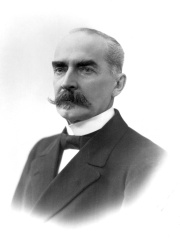
10. Kaarlo Juho Ståhlberg (1865 - 1952)
With an HPI of 69.00, Kaarlo Juho Ståhlberg is the 10th most famous Finnish Politician. His biography has been translated into 54 different languages.
Kaarlo Juho Ståhlberg (forenames Finnish: [ˈkɑːrlo ˈjuho], surname Finland Swedish: [ˈstoːlbærj]; 28 January 1865 – 22 September 1952) was a Finnish jurist and academic who was one of the most important pioneers of republicanism in the country. He was the first president of Finland (1919–1925) and a liberal nationalist. Ståhlberg was an important figure in the drafting of Finland's republican constitution. As a jurist, he anchored the state in liberal democracy, guarded the fragile germ of the rule of law, and embarked on internal reforms. In implementing the form of government of 1919, Ståhlberg piloted an independent Finland towards acting in world politics; in presidential-led foreign and security policy, he relied on international law and diplomacy. It was only after the opening of private archives of President J. K. Paasikivi that it was realized that Ståhlberg had a very significant political role as an “éminence grise” until his death. He was asked for advice and opinions, which were also followed. Paasikivi highly valued Ståhlberg, and even described his predecessor in exaggerated words: “Ståhlberg was a man who never made mistakes”.
People
Pantheon has 120 people classified as Finnish politicians born between 1535 and 1999. Of these 120, 58 (48.33%) of them are still alive today. The most famous living Finnish politicians include Tarja Halonen, Sauli Niinistö, and Alexander Stubb. The most famous deceased Finnish politicians include Carl Gustaf Emil Mannerheim, Urho Kekkonen, and Juho Kusti Paasikivi. As of April 2024, 11 new Finnish politicians have been added to Pantheon including Henna Virkkunen, Anu Vehviläinen, and Mari Rantanen.
Living Finnish Politicians
Go to all RankingsTarja Halonen
1943 - Present
HPI: 75.27
Sauli Niinistö
1948 - Present
HPI: 73.22
Alexander Stubb
1968 - Present
HPI: 66.76
Petteri Orpo
1969 - Present
HPI: 64.05
Paavo Lipponen
1941 - Present
HPI: 62.47
Matti Vanhanen
1955 - Present
HPI: 62.38
Sanna Marin
1985 - Present
HPI: 61.00
Anneli Jäätteenmäki
1955 - Present
HPI: 60.51
Antti Rinne
1962 - Present
HPI: 60.18
Mari Kiviniemi
1968 - Present
HPI: 60.08
Juha Sipilä
1961 - Present
HPI: 59.66
Pekka Haavisto
1958 - Present
HPI: 58.87
Deceased Finnish Politicians
Go to all RankingsCarl Gustaf Emil Mannerheim
1867 - 1951
HPI: 81.28
Urho Kekkonen
1900 - 1986
HPI: 74.02
Juho Kusti Paasikivi
1870 - 1956
HPI: 73.17
Risto Ryti
1889 - 1956
HPI: 71.68
Pehr Evind Svinhufvud
1861 - 1944
HPI: 71.36
Mauno Koivisto
1923 - 2017
HPI: 70.57
Kyösti Kallio
1873 - 1940
HPI: 69.79
Kaarlo Juho Ståhlberg
1865 - 1952
HPI: 69.00
Otto Wille Kuusinen
1881 - 1964
HPI: 68.80
Grand Duke Vladimir Kirillovich of Russia
1917 - 1992
HPI: 67.99
Hjalmar Siilasvuo
1892 - 1947
HPI: 67.98
Antti Aarne
1867 - 1925
HPI: 67.04
Newly Added Finnish Politicians (2025)
Go to all RankingsHenna Virkkunen
1972 - Present
HPI: 50.30
Anu Vehviläinen
1963 - Present
HPI: 44.77
Mari Rantanen
1976 - Present
HPI: 41.44
Carl Haglund
1979 - Present
HPI: 40.70
Paavo Arhinmäki
1976 - Present
HPI: 39.06
Teuvo Teräväinen
1994 - Present
HPI: 36.81
Sakari Manninen
1992 - Present
HPI: 35.85
Eeli Tolvanen
1999 - Present
HPI: 35.74
Jenni Hiirikoski
1987 - Present
HPI: 35.00
Miro Aaltonen
1993 - Present
HPI: 34.75
Jonas Enlund
1987 - Present
HPI: 34.73
Overlapping Lives
Which Politicians were alive at the same time? This visualization shows the lifespans of the 25 most globally memorable Politicians since 1700.

